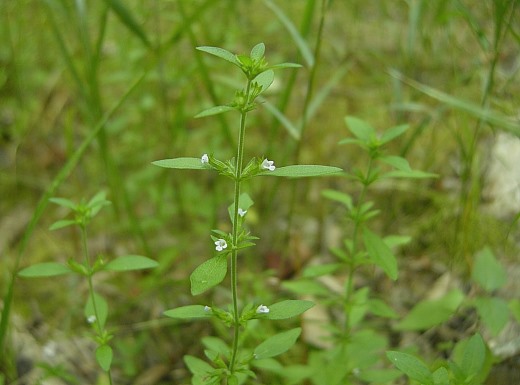Description: This wildflower is a summer annual about 4-12" tall that is branched or unbranched. The stems are light green, terete, and pubescent. The opposite leaves are about 1" long and ¼" across; they are elliptic, oblong-lanceolate, or oblong-oblanceolate in shape. The margins of the leaves are smooth or they have a few blunt teeth toward their tips. The petioles of the leaves are short and slender. The foliage of American Pennyroyal has a strong medicinal-mint scent. Small axillary clusters of 1-4 flowers are produced from the base of each middle to upper leaf. Each flower is about ¼" long and half as much across, consisting of a 2-lipped tubular corolla, a tubular calyx with 5 teeth, 2 stamens, and a 4-celled ovary with a single style. The corolla is white or blue-violet with a contrasting color near its throat. Along the outer rim of the corolla, there is an upper lobe, 2 lateral lobes, and a lower lobe; they are short and rounded (although not always well-defined). The hairy ridged calyx has 3 upper triangular teeth and 2 lower teeth that are slender-lanceolate. At the base of each flower, there is a pair of a leafy bracts; these bracts are at least as long as the flower. The blooming period occurs from mid-summer to early fall and lasts 1-3 months; individual flowers are short-lived. At maturity, each fertile flower is replaced by 4 nutlets. This wildflower reproduces by reseeding itself. It occasionally forms colonies at favorable sites.

Cultivation: The
preference is full sun to light shade, mesic to dry conditions, and
soil that is rocky or loamy. Plants that are grown in sunny locations
require more moisture than those growing in shade. Barren or disturbed
locations that are largely devoid of ground vegetation are preferred,
as this reduces competition from taller plants.
Range & Habitat:
The native American Pennyroyal is occasional to locally common
throughout
Illinois, except the NW section of the state, where it is less common
(see Distribution
Map). Habitats include dry upland woodlands, rocky woodlands,
areas along woodland trails, rocky glades, areas along railroads,
roadsides, pastures, and fallow fields. This species prefers areas
(whether sunny or shaded) that have been subjected to some disturbance.
Faunal Associations:
Small bees pollinate the flowers, where they seek nectar and pollen.
These visitors include little carpenter bees (Ceratina spp.),
Halictid bees (Augochlorella spp., Halictus
spp., & Lasioglossum spp.), and
the dagger bee Calliopsis andreniformis. Syrphid
flies may visit the flowers occasionally, but they feed on the pollen
and are less effective at pollination. The strong scent of the foliage
protects this plant from mammalian herbivores.

Photographic Location:
An upland area of Busey Woods in
Urbana, Illinois.
Comments:
The most remarkable thing about this little plant is the strong scent
of the foliage. Otherwise, it is rather easy to overlook. The only
other species in this genus that occurs in Illinois, Hedeoma
hispida (Rough Pennyroyal), has linear leaves and a milder
scent; it also prefers sunnier habitats. American Pennyroyal
superficially resembles Gratiola neglecta (Clammy
Hedge Hyssop), but this latter species lacks any fragrance and its
prefers soggy habitats (e.g., damp depressions in woodlands). Native
pennyroyal species (Hedeoma spp.) have only 2
stamens per flower, while other similar species in the Mint family
often have 4 stamens per flower. Because the flowers are so small, this
requires a 10x hand lens to see clearly.